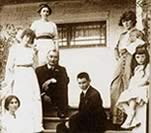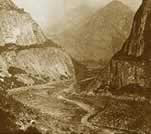|




|
Michael "Chief" O'Shaughnessy,
B.E. (1864-1934)
 Michael
O'Shaughnessy graduated in Civil Engineering from Queen's College Galway
in 1884 and for a long number of years was Chief Engineer of the City of
San Francisco, undertaking the building of new infrastructures for the city
after the disastrous earthquake and fires of 1906. Michael
O'Shaughnessy graduated in Civil Engineering from Queen's College Galway
in 1884 and for a long number of years was Chief Engineer of the City of
San Francisco, undertaking the building of new infrastructures for the city
after the disastrous earthquake and fires of 1906.
These works included the construction of the Twin Peaks tunnel, the famous
Seashore Wall, the Streetcar (tramway) system and, greatest of all, the
San Francisco Water-Supply and Electric-Power project, involving dams, powerhouses
and 160 miles of transmission towers, pipelines and tunnels the whole way
to the City from the O'Shaughnessy Dam (named in his honour) in the Sierra
Nevada (Yosemite National Park), an area generally under snow and ice for
most of the winter.
The Hetch-Hetchy project, as it is sometimes called, is numbered among the
great engineering projects of the twentieth century. As City Engineer, O'Shaughnessy
was also closely involved in the long-running controversy surrounding the
proposal to build the Golden Gate Bridge. He died aged 70 in 1934 just a
few days before the celebrations which had been planned to honour him following
the arrival in the City of the first water from the great Dam, and four
years before the Bridge, the construction of which was already well under
way, was opened to traffic.
"Chief" O'Shaughnessy was appointed City Engineer of San Francisco
in 1912 and he held this office until his retirement in 1932, after which
he became Consulting Engineer to the City's Public Utilities Commission.
Among the many difficult tasks which he had to perform was to convince the
U. S. Congress to grant the necessary permissions for the enormous Hetch
Hetchy Power & Water Supply Scheme; he spent many weeks in Washington
actively lobbying for support and being examined by members of the Senate.
During one particular
week he was examined continuously from Monday morning until late on Saturday
evening. In spite of strenuous opposition, largely from vested interests,
he eventually secured the necessary approvals, which were signed by President
Wilson in 1913. In his own words "I never handled any proposition where
the engineering problems were so simple and the political ones so complex".
He was, of course, being his usual modest self about his Engineering skills!
Even to the layman, the site chosen for the dam must appear ideal for its
purpose. In addition to the splendid topography of the valley, the fact
that the mountains are largely granite made this location unbeatable in
spite of its distance, 160 miles, from San Francisco. The area of the watershed
contributing to the reservoir behind the O'Shaughnessy Dam is roughly 460
sq. miles (1, 150 sq. km.); the total watershed for the entire project exceeds
650 sq. miles. (1,620 sq.km)
In 1912, at the beginning
of the Hetch Hetchy Project, there were few roads and no motorcars in
the High Sierras. The building of a mountain railway, the Hetch Hetchy
Rail Road (H.H.R.R.) was the first task 0' Shaughnessy set himself. All
the materials for its construction came by mule trains like the one shown
here. There were long rail tunnels, and many bridges, to be built before
any thought could be given to starting the construction of the permanent
Works, namely, the Dams, the Power-plants and the aquaduct itself.
O'Shaughnessy was not, of course, picked out of no-where to take over
as Chief Engineer of San Francisco; his earlier career made him the obvious
choice. Among his earlier employments were:
- Engineer with the
Southern Pacific Railroad and with the Sierra Valley and Mohawk Railroad
- Chief Engineer
of the Mountain Copper Company where he built 12 miles of narrow gauge
mountain railroad
- He spent some time
in Hawaii building an aggregate of about thirty miles of large irrigation
conduit and some twenty miles of tunnel
- He constructed
the 260 ft high Morena Dam and 13 miles of conduit with seventeen tunnels
for the City of San Diego
He had all the necessary
experience in building dams, tunnels, conduits and railroads which were
the essential parts of the great Hetch Hetchy Scheme and he had no trouble
turning his mind to the design of sea-defence works, tramway systems and
other urban design projects in San Francisco.
|



Michael O'Shaugnessy with his family on the steps of their unpretentious
house, his wife, Mary, stands behind Michael. Also included is their son
John, who died young, and their four daughters. Three of their daughters
then surviving, Mary, Helen, and Elizabeth, visited Prof. Declan O'Keeffe
in the Engineering School in Galway in the sixties and thus started a
correspondence which he maintained with them until the last daughter,
Elizabeth, died in 1998.

In 1923, nine years
after it's construction had begun, the dam was first brought into service.
It was later raised to a greater height to increase the capacity of the
reservoir.This additional work had, of course, been part of the original
design. The need for adequate water supply has plagued most of California
in recent years, but water is no problem for San Francisco, thanks to
the foresight of Michael O'Shaughnessy.

The splendid topography
of the valley made this location for the dam unbeatable, in spite of it's
location in unmapped wilderness 160 miles from San Francisco.

All of the construction
materials for the temporary mountain railway, the Hetch Hetchy Rail Road,
including those for the many tunnels, were brought by mule trains like
this one.
|
|

